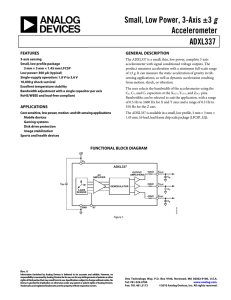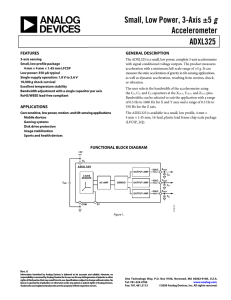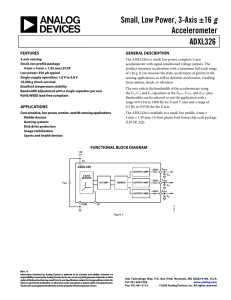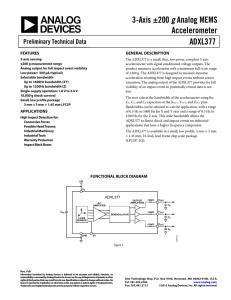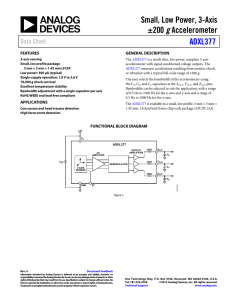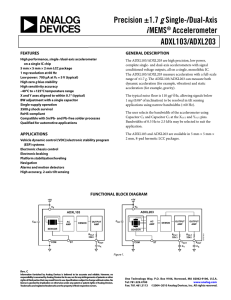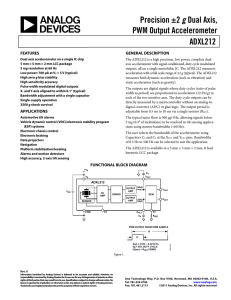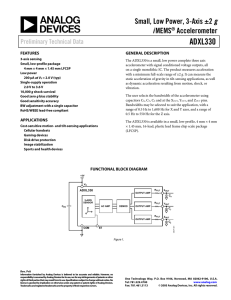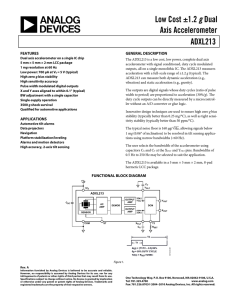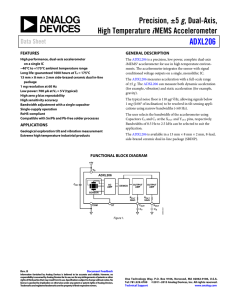Small, Low Power, g ADXL316 Data Sheet
advertisement
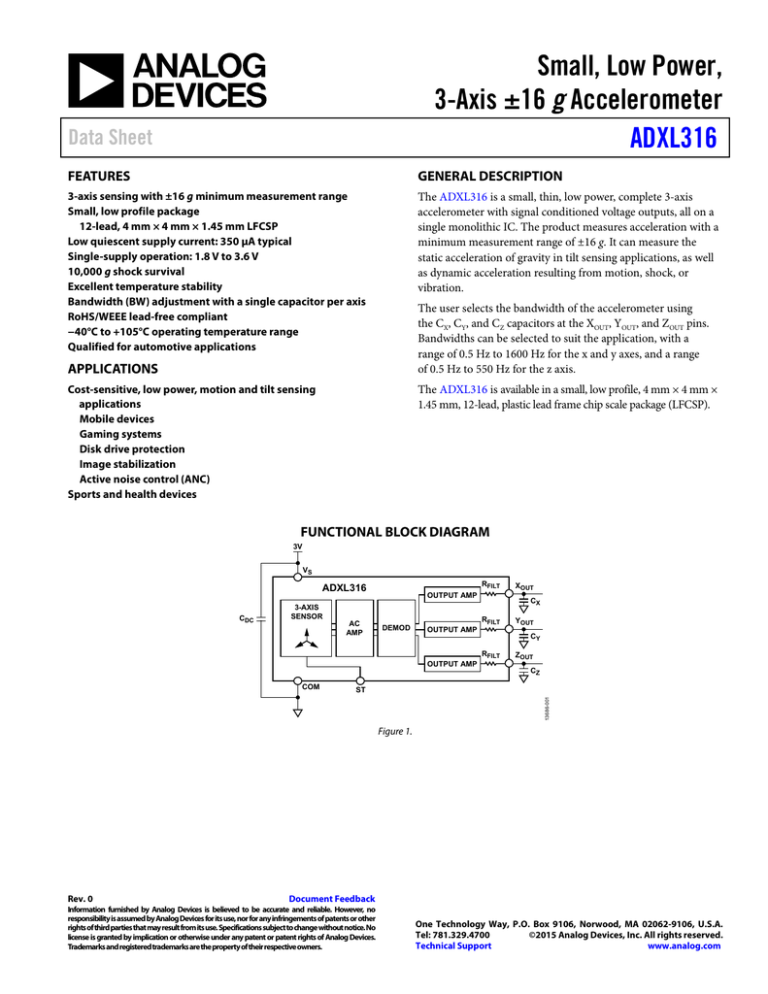
Small, Low Power, 3-Axis ±16 g Accelerometer ADXL316 Data Sheet FEATURES GENERAL DESCRIPTION 3-axis sensing with ±16 g minimum measurement range Small, low profile package 12-lead, 4 mm × 4 mm × 1.45 mm LFCSP Low quiescent supply current: 350 µA typical Single-supply operation: 1.8 V to 3.6 V 10,000 g shock survival Excellent temperature stability Bandwidth (BW) adjustment with a single capacitor per axis RoHS/WEEE lead-free compliant −40°C to +105°C operating temperature range Qualified for automotive applications The ADXL316 is a small, thin, low power, complete 3-axis accelerometer with signal conditioned voltage outputs, all on a single monolithic IC. The product measures acceleration with a minimum measurement range of ±16 g. It can measure the static acceleration of gravity in tilt sensing applications, as well as dynamic acceleration resulting from motion, shock, or vibration. The user selects the bandwidth of the accelerometer using the CX, CY, and CZ capacitors at the XOUT, YOUT, and ZOUT pins. Bandwidths can be selected to suit the application, with a range of 0.5 Hz to 1600 Hz for the x and y axes, and a range of 0.5 Hz to 550 Hz for the z axis. APPLICATIONS The ADXL316 is available in a small, low profile, 4 mm × 4 mm × 1.45 mm, 12-lead, plastic lead frame chip scale package (LFCSP). Cost-sensitive, low power, motion and tilt sensing applications Mobile devices Gaming systems Disk drive protection Image stabilization Active noise control (ANC) Sports and health devices FUNCTIONAL BLOCK DIAGRAM 3V VS RFILT ADXL316 CDC OUTPUT AMP 3-AXIS SENSOR AC AMP DEMOD CX RFILT OUTPUT AMP ZOUT CZ ST 13686-001 COM YOUT CY RFILT OUTPUT AMP XOUT Figure 1. Rev. 0 Document Feedback Information furnished by Analog Devices is believed to be accurate and reliable. However, no responsibility is assumed by Analog Devices for its use, nor for any infringements of patents or other rights of third parties that may result from its use. Specifications subject to change without notice. No license is granted by implication or otherwise under any patent or patent rights of Analog Devices. Trademarks and registered trademarks are the property of their respective owners. One Technology Way, P.O. Box 9106, Norwood, MA 02062-9106, U.S.A. Tel: 781.329.4700 ©2015 Analog Devices, Inc. All rights reserved. Technical Support www.analog.com ADXL316 Data Sheet TABLE OF CONTENTS Features .............................................................................................. 1 Applications Information .............................................................. 11 Applications ....................................................................................... 1 Power Supply Decoupling ......................................................... 11 General Description ......................................................................... 1 Setting the Bandwidth Using CX, CY, and CZ .......................... 11 Functional Block Diagram .............................................................. 1 Self Test ........................................................................................ 11 Revision History ............................................................................... 2 Specifications..................................................................................... 3 Design Trade-Offs for Selecting Filter Characteristics: The Noise/BW Trade-Off .................................................................. 11 Absolute Maximum Ratings ............................................................ 4 Use with Operating Voltages other than 3 V .............................. 12 ESD Caution .................................................................................. 4 Axes of Acceleration Sensitivity ............................................... 12 Pin Configuration and Function Descriptions ............................. 5 Layout and Design Recommendations........................................ 13 Typical Performance Characteristics ............................................. 6 Outline Dimensions ....................................................................... 14 Theory of Operation ...................................................................... 10 Ordering Guide .......................................................................... 14 Mechanical Sensor...................................................................... 10 Automotive Products ................................................................. 14 Performance ................................................................................ 10 REVISION HISTORY 10/15—Revision 0: Initial Version Rev. 0 | Page 2 of 14 Data Sheet ADXL316 SPECIFICATIONS TA = 25°C, VS = 3 V, CX = CY = CZ = 0.1 µF, acceleration = 0 g, unless otherwise noted. All minimum and maximum specifications are guaranteed. Typical specifications are not guaranteed. Table 1. Parameter SENSOR INPUT Measurement Range1 Nonlinearity Package Alignment Error Interaxis Alignment Error Cross Axis Sensitivity SENSITIVITY (RATIOMETRIC)2 Sensitivity at XOUT, YOUT, and ZOUT Sensitivity Change due to Temperature3 ZERO g BIAS LEVEL (RATIOMETRIC) 0 g Voltage at XOUT, YOUT, and ZOUT Initial 0 g Output Deviation from Ideal 0 g Offset vs. Temperature NOISE PERFORMANCE Output Noise Noise Density XOUT and YOUT ZOUT FREQUENCY RESPONSE4 XOUT and YOUT Bandwidth5 ZOUT Bandwidth 5 RFILT Tolerance Sensor Resonant Frequency SELF TEST (ST)6 Logic Input Low Logic Input High ST Input Resistance to Ground Output Change At XOUT At YOUT At ZOUT OUTPUT AMPLIFIER Output Swing Low High POWER SUPPLY Operating Voltage Range Quiescent Supply Current Turn-On Time7 OPERATING TEMPERATURE RANGE Test Conditions/Comments Each axis Min Typ ±16 ±19 ±0.2 ±1 ±0.1 ±1 50 57 ±0.5 64 mV/g mV 1.2 1.5 ±100 ±1 1.8 V mV mg/°C % of measurement range Each axis VS = 3 V VS = 3 V Each axis VS = 3 V, 25°C VS = 3 V, 25°C <4 kHz, VS = 3 V No external filter No external filter 27 Max Unit g % Degrees Degrees % 1 mV 210 450 µg/√Hz rms µg/√Hz rms 1600 550 32 4.2 Hz Hz kΩ kHz 2.7 30 50 −65 35 70 −50 50 90 37 0.3 V V kΩ −35 65 110 mV mV mV ST = 0 to ST = 1 No load No load 0.1 2.8 1.8 V V 3.6 350 10 −40 1 +105 V µA ms °C Guaranteed by measurement of initial offset and sensitivity. Sensitivity is essentially ratiometric to VS. Calculate sensitivity by using a scale factor (mV/V/g). Sensitivity = Scale Factor × VS. To calculate minimum and maximum sensitivity, the scale factors are 15 mV/V/g and 23 mV/V/g, respectively. 3 This parameter is defined as the output change from ambient to maximum temperature or ambient to minimum temperature. 4 Actual frequency response controlled by user-supplied external filter capacitors (CX, CY, and CZ). 5 Bandwidth = 1/(2 × π × 32 kΩ × C). For CX, CY = 0.003 µF, the bandwidth = 1.6 kHz. For CZ = 0.01 µF, the bandwidth = 500 Hz. For CX, CY, and CZ = 10 µF, the bandwidth = 0.5 Hz. 6 Self test response changes cubically with VS. 7 Larger values of CX, CY, and CZ increase turn-on time. Turn-on time is approximately 160 × (CX, CY, and CZ) + 4 ms, where CX, CY, CZ are in µF. 2 Rev. 0 | Page 3 of 14 ADXL316 Data Sheet ABSOLUTE MAXIMUM RATINGS ESD CAUTION Table 2. Parameter Acceleration Shock Survival, Any Axis, and Unpowered Shock Survival, Any Axis, and Powered VS All Other Pins Output Short-Circuit Duration (Any Pin to COM) Temperature Range (Powered) Rating 10,000 g 10,000 g −0.3 V to +3.6 V (COM − 0.3 V) to (VS + 0.3 V) Indefinite −55°C to +125°C Stresses at or above those listed under Absolute Maximum Ratings may cause permanent damage to the product. This is a stress rating only; functional operation of the product at these or any other conditions above those indicated in the operational section of this specification is not implied. Operation beyond the maximum operating conditions for extended periods may affect product reliability. Rev. 0 | Page 4 of 14 Data Sheet ADXL316 PIN CONFIGURATION AND FUNCTION DESCRIPTIONS ADXL316 11 DNC 10 DNC 12 VS TOP VIEW (Not to Scale) 9 XOUT DNC 1 8 YOUT 7 DNC NOTES 1. DNC = DO NOT CONNECT. DO NOT CONNECT TO THIS PIN. 2. THE EXPOSED PAD IS NOT INTERNALLY CONNECTED. SOLDER FOR MECHANICAL INTEGRITY. 13686-002 DNC 4 COM 3 DNC 5 +Z +X +Y ZOUT 6 ST 2 Figure 2. Pin Configuration Table 3. Pin Function Descriptions Pin No. 1 2 3 4 5 6 7 8 9 10 11 12 Mnemonic DNC ST COM DNC DNC ZOUT DNC YOUT XOUT DNC DNC VS EP Description Do Not Connect. Self Test. Ground. Do Not Connect. Do Not Connect. Z Channel Output. Do Not Connect. Y Channel Output. X Channel Output. Do Not Connect. Do Not Connect. Supply Voltage (1.8 V to 3.6 V). Exposed Pad. The exposed pad is not internally connected. Solder for mechanical integrity. Rev. 0 | Page 5 of 14 ADXL316 Data Sheet TYPICAL PERFORMANCE CHARACTERISTICS 30 50 25 40 20 30 20 15 10 10 5 0 0 13686-003 OUTPUT (V) –65 –63 –61 –59 –57 –55 –53 –51 –49 –47 –45 –43 –41 –39 –37 –35 SELF TEST (mV) Figure 3. X-Axis Zero g Bias at 25°C, VS = 3 V 13686-006 POPULATION (%) 60 1.40 1.41 1.42 1.43 1.44 1.45 1.46 1.47 1.48 1.49 1.50 1.51 1.52 1.53 1.54 1.55 1.56 1.57 1.58 1.59 1.60 POPULATION (%) N (number of devices tested) > 1000 for all typical performance plots, unless otherwise noted. Figure 6. X-Axis Self Test Response at 25°C, VS = 3 V 70 25 60 20 POPULATION (%) POPULATION (%) 50 40 30 15 10 20 5 35 37 39 41 43 45 47 49 51 53 55 57 59 61 63 65 SELF TEST (mV) Figure 7. Y-Axis Self Test Response at 25°C, VS = 3 V Figure 4. Y-Axis Zero g Bias at 25°C, VS = 3 V 18 16 16 14 14 12 POPULATION (%) 12 10 8 6 10 8 6 0 0 OUTPUT (V) SELF TEST (mV) Figure 5. Z-Axis Zero g Bias at 25°C, VS = 3 V Figure 8. Z-Axis Self Test Response at 25°C, VS = 3 V Rev. 0 | Page 6 of 14 13686-008 2 13686-005 2 70 72 74 76 78 80 82 84 86 88 90 92 94 96 98 100 102 104 106 108 110 4 4 1.40 1.41 1.42 1.43 1.44 1.45 1.46 1.47 1.48 1.49 1.50 1.51 1.52 1.53 1.54 1.55 1.56 1.57 1.58 1.59 1.60 POPULATION (%) 13686-007 OUTPUT (V) 0 13686-004 0 1.40 1.41 1.42 1.43 1.44 1.45 1.46 1.47 1.48 1.49 1.50 1.51 1.52 1.53 1.54 1.55 1.56 1.57 1.58 1.59 1.60 10 Data Sheet ADXL316 1.55 12 N > 100 N=8 1.53 8 OUTPUT (V) 6 1.51 1.49 4 1.47 2 –10–9 –8 –7 –6 –5 –4 –3 –2 –1 0 1 2 3 4 5 6 7 8 9 10 TEMPERATURE COEFFICIENT (mg/°C) 1.45 –40 13686-009 0 –20 0 20 40 60 80 100 TEMPERATURE (°C) Figure 9. X-Axis Zero g Bias Temperature Coefficient, VS = 3 V 13686-012 POPULATION (%) 10 Figure 12. X-Axis Zero g Bias vs. Temperature 1.55 14 N > 100 N=8 12 1.53 OUTPUT (V) POPULATION (%) 10 8 6 1.51 1.49 4 1.47 –10–9 –8 –7 –6 –5 –4 –3 –2 –1 0 1 2 3 4 5 6 7 8 9 10 TEMPERATURE COEFFICIENT (mg/°C) 1.45 –40 13686-010 0 –20 0 20 40 60 80 100 TEMPERATURE (°C) Figure 10. Y-Axis Zero g Bias Temperature Coefficient, VS = 3 V 13686-013 2 Figure 13. Y-Axis Zero g Bias vs. Temperature 1.55 18 N > 100 N=8 16 1.53 OUTPUT (V) 12 10 8 1.51 1.49 6 4 1.47 0 –10–9 –8 –7 –6 –5 –4 –3 –2 –1 0 1 2 3 4 5 6 7 8 9 10 TEMPERATURE COEFFICIENT (mg/°C) 1.45 –40 –20 0 20 40 60 80 TEMPERATURE (°C) Figure 11. Z-Axis Zero g Bias Temperature Coefficient, VS = 3 V Figure 14. Z-Axis Zero g Bias vs. Temperature Rev. 0 | Page 7 of 14 100 13686-014 2 13686-011 POPULATION (%) 14 ADXL316 Data Sheet 25 64 N=8 62 20 SENSITIVITY (mV) POPULATION (%) 60 15 10 58 56 54 5 50 51 52 53 54 55 56 57 58 59 60 61 62 63 64 SENSITIVITY (mV/g) 50 –40 13686-015 0 –20 0 20 40 60 80 100 TEMPERATURE (°C) Figure 15. X-Axis Sensitivity at 25°C, VS = 3 V 13686-018 52 Figure 18. X-Axis Sensitivity vs. Temperature, VS = 3 V 64 25 N=8 62 20 SENSITIVITY (mV) POPULATION (%) 60 15 10 58 56 54 5 50 51 52 53 54 55 56 57 58 59 60 61 62 63 64 SENSITIVITY (mV/g) 50 –40 13686-016 0 –20 0 20 40 60 80 100 TEMPERATURE (°C) Figure 16. Y-Axis Sensitivity at 25°C, VS = 3 V 13686-019 52 Figure 19. Y-Axis Sensitivity vs. Temperature, VS = 3 V 35 64 30 62 25 60 15 58 56 10 54 5 52 0 50 51 52 53 54 55 56 57 58 59 60 61 62 63 64 SENSITIVITY (mV/g) 50 –40 –20 0 20 40 60 80 TEMPERATURE (°C) Figure 17. Z-Axis Sensitivity at 25°C, VS = 3 V Figure 20. Z-Axis Sensitivity vs. Temperature, VS = 3 V Rev. 0 | Page 8 of 14 100 13686-021 SENSITIVITY (mV) 20 13686-017 POPULATION (%) N=8 Data Sheet ADXL316 450 400 300 250 200 150 100 50 0 1.5 2.0 2.5 3.0 3.5 4.0 SUPPLY (V) 13686-022 CURRENT (μA) 350 Figure 21. Typical Current Consumption vs. Supply Voltage Rev. 0 | Page 9 of 14 ADXL316 Data Sheet THEORY OF OPERATION The ADXL316 is a complete 3-axis acceleration measurement system. The ADXL316 has a measurement range of ±16 g minimum. It contains a polysilicon surface micromachined sensor and signal conditioning circuitry to implement an openloop acceleration measurement architecture. The output signals are analog voltages that are proportional to acceleration. The accelerometer can measure the static acceleration of gravity in tilt sensing applications as well as dynamic acceleration resulting from motion, shock, or vibration. The sensor is a polysilicon surface micromachined structure built on top of a silicon wafer. Polysilicon springs suspend the structure over the surface of the wafer and provide a resistance against acceleration forces. Deflection of the structure is measured using a differential capacitor that consists of independent fixed plates and plates attached to the moving mass. The fixed plates are driven by 180° out-of-phase square waves. Acceleration deflects the moving mass and unbalances the differential capacitor, resulting in a sensor output with an amplitude proportional to acceleration. Phase-sensitive demodulation techniques determine the magnitude and direction of the acceleration. A 32 kΩ resistor can amplify and bring the demodulator output off-chip. The user then sets the signal bandwidth of the device by adding a capacitor. This filtering improves measurement resolution and helps prevent aliasing. MECHANICAL SENSOR The ADXL316 uses a single structure for sensing the X-, Y-, and Z-axes. As a result, the three axes sense directions are highly orthogonal with minimal cross axis sensitivity. Mechanical misalignment of the sensor die to the package is the chief source of cross axis sensitivity. Mechanical misalignment can be calibrated out at the system level. PERFORMANCE Rather than using additional temperature compensation circuitry, innovative design techniques ensure high performance is built-in to the ADXL316. As a result, there is neither quantization error nor nonmonotonic behavior, and temperature hysteresis is very low. Rev. 0 | Page 10 of 14 Data Sheet ADXL316 APPLICATIONS INFORMATION POWER SUPPLY DECOUPLING SELF TEST For most applications, a single 0.1 µF capacitor, CDC, placed close to the ADXL316 supply pins adequately decouples the accelerometer from noise on the power supply. However, in applications where noise is present at the 50 kHz internal clock frequency (or any harmonic thereof), additional care in power supply bypassing is required because this noise can cause errors in acceleration measurement. If additional decoupling is needed, a 100 Ω (or smaller) resistor or a ferrite bead can be inserted in the supply line. Additionally, a larger bulk bypass capacitor (1 µF or greater) can be added in parallel to CDC. Ensure that the connection from the ADXL316 ground to the power supply ground is low impedance, because noise transmitted through ground has a similar effect as noise transmitted through VS. The ST pin controls the self test feature. When this pin is connected to VS, an electrostatic force is exerted on the accelerometer beam. The resulting movement of the beam allows the user to test if the accelerometer is functional. The typical change in output is −0.88 g (corresponding to −50 mV) on the x-axis, 0.88 g (or +50 mV) on the y-axis, and 1.58 g (or +90 mV) on the z-axis. The ST pin may be left open circuit or connected to the common pin (COM) in normal use. SETTING THE BANDWIDTH USING CX, CY, AND CZ The ADXL316 has provisions for band-limiting the XOUT, YOUT, and ZOUT pins. Capacitors must be added at these pins to implement low-pass filtering for antialiasing and noise reduction. The equation for the −3 dB bandwidth is f−3 dB = 1/(2π(32 kΩ) × C(X, Y, Z)) or more simply f–3 dB = 5 µF/C(X, Y, Z) The tolerance of the internal resistor (RFILT) can vary by as much as ±15% of its nominal value (32 kΩ), and the bandwidth varies accordingly. A minimum capacitance of 0.0047 µF for CX, CY, and CZ is recommended in all cases. Table 4. Filter Capacitor Selection, CX, CY, and CZ Bandwidth (Hz) 1 10 50 100 200 500 Capacitor (µF) 4.7 0.47 0.10 0.05 0.027 0.01 Never expose the ST pin to voltages greater than VS + 0.3 V. If this cannot be guaranteed due to the system design (for instance, if there are multiple supply voltages), a low VF clamping diode between ST and VS is recommended. DESIGN TRADE-OFFS FOR SELECTING FILTER CHARACTERISTICS: THE NOISE/BW TRADE-OFF The selected accelerometer bandwidth ultimately determines the measurement resolution (the smallest detectable acceleration). Filtering can lower the noise floor to improve the resolution of the accelerometer. Resolution is dependent on the analog filter bandwidth at XOUT, YOUT, and ZOUT. The output of the ADXL316 has a typical bandwidth of greater than 500 Hz. The user must filter the signal at this point to limit aliasing errors. The analog bandwidth must be no more than half the analog-to-digital sampling frequency to minimize aliasing. The analog bandwidth can decrease further to reduce noise and improve resolution. The ADXL316 has white Gaussian noise, which contributes equally at all frequencies and is described in terms of µg/√Hz (the noise is proportional to the square root of the accelerometer bandwidth). Limit bandwidth to the lowest frequency needed by the application to maximize the resolution and dynamic range of the accelerometer. With the single-pole roll-off characteristic, the typical rms noise of the ADXL316 is determined by RMS Noise = Noise Density × ( BW × 1.6 ) Often, the peak value of the noise is desired. Statistical methods can only estimate peak-to-peak noise. Table 5 is useful for estimating the probabilities of exceeding various peak values, given the rms value. Table 5. Estimation of Peak-to-Peak Noise Peak-to-Peak Value 2 × rms 4 × rms 6 × rms 8 × rms Rev. 0 | Page 11 of 14 % of Time that Noise Exceeds Nominal Peak-to-Peak Value 32 4.6 0.27 0.006 ADXL316 Data Sheet USE WITH OPERATING VOLTAGES OTHER THAN 3 V The supply current decreases as the supply voltage decreases. Typical current consumption at VS = 3.6 V is 400 µA, and typical current consumption at VS = 2 V is 300 µA. The ADXL316 is tested and specified at VS = 3 V; however, it can be powered with VS as low as 1.8 V or as high as 3.6 V. Note that some performance parameters change as the supply voltage is varied. AXES OF ACCELERATION SENSITIVITY Figure 22 shows the axes of acceleration (AX, AY, and AZ) sensitivity, corresponding output voltage increases when accelerated along the sensitive axis. The ADXL316 outputs are ratiometric, so the output sensitivity (or scale factor) is proportional to the supply voltage. At VS = 3.6 V, the output sensitivity is typically 78 mV/g. At VS = 2 V, the output sensitivity is typically 42 mV/g. AZ The zero g bias output is also ratiometric, so the zero g output is nominally equal to VS/2 at all supply voltages. Self test response in g is roughly proportional to the square of the supply voltage. However, when ratiometricity of sensitivity is factored in with supply voltage, the self test response in volts is roughly proportional to the cube of the supply voltage. For example, at VS = 3.6 V, the self test response for the ADXL316 is approximately −86 mV for the x-axis, +86 mV for the y-axis, and +162 mV for the z-axis. At VS = 2 V, the self test response is approximately −14 mV for the x-axis, +14 mV for the y-axis, and +28 mV for the z-axis. AX Figure 22. Axes of Acceleration (AX, AY, and AZ) Sensitivity XOUT = +1g YOUT = 0g ZOUT = 0g TOP TOP XOUT = 0g YOUT = +1g ZOUT = 0g XOUT = –1g YOUT = 0g ZOUT = 0g XOUT = 0g YOUT = 0g ZOUT = +1g Figure 23. Output Response vs. Orientation to Gravity Rev. 0 | Page 12 of 14 XOUT = 0g YOUT = 0g ZOUT = –1g 13686-024 TOP XOUT = 0g YOUT = –1g ZOUT = 0g TOP GRAVITY 13686-023 AY The output noise is not ratiometric but is absolute in volts; therefore, the noise density decreases as the supply voltage increases. This decrease is because the scale factor (mV/g) increases while the noise voltage remains constant. At VS = 3.6 V, the x-axis and y-axis noise density is typically 150 µg/√Hz, while at VS = 2 V, the x-axis and y-axis noise density is typically 280 µg/√Hz. Data Sheet ADXL316 LAYOUT AND DESIGN RECOMMENDATIONS The recommended soldering profile is shown in Figure 24, followed by a description of the recommended soldering profile features in Table 6. CRITICAL ZONE TL TO TP tP TP tL TSMAX TSMIN tS RAMP-DOWN PREHEAT 13686-025 TEMPERATURE RAMP-UP TL t25°C TO PEAK TIME Figure 24. Recommended Soldering Profile Table 6. Recommended Soldering Profile Profile Feature Average Ramp Rate (TL to TP) Preheat Minimum Temperature (TSMIN) Maximum Temperature (TSMAX) Time (TSMIN to TSMAX), tS TSMAX to TL Ramp-Up Rate Time Maintained Above Liquidous (TL) Liquidous Temperature (TL) Time (tL) Peak Temperature (TP) Time within 5°C of Actual Peak Temperature (tP) Ramp-Down Rate Time 25°C (t25°C) to Peak Temperature Rev. 0 | Page 13 of 14 Sn63/Pb37 3°C/sec maximum Pb-Free 3°C/sec maximum 100°C 150°C 60 sec to 120 sec 150°C 200°C 60 sec to 180 sec 3°C/sec maximum 3°C/sec maximum 183°C 60 sec to 150 sec 240°C + 0°C/−5°C 10 sec to 30 sec 6°C/sec maximum 6 minutes maximum 217°C 60 sec to 150 sec 260°C + 0°C/−5°C 20 sec to 40 sec 6°C/sec maximum 8 minutes maximum ADXL316 Data Sheet OUTLINE DIMENSIONS PIN 1 INDICATOR 4.10 4.00 SQ 3.90 0.40 0.35 0.30 0.55 0.50 0.45 PIN 1 INDICATOR 12 10 1.00 BSC 9 1 2.20 2.10 2.00 EXPOSED PAD 0.33 MIN 7 TOP VIEW 1.50 1.45 1.40 0.58 0.50 0.44 3 BOTTOM VIEW 2.60 2.50 2.40 0.05 MAX 0.02 NOM COPLANARITY 0.08 0.152 REF 0.20 MIN 0.23 0.15 0.07 FOR PROPER CONNECTION OF THE EXPOSED PAD, REFER TO THE PIN CONFIGURATION AND FUNCTION DESCRIPTIONS SECTION OF THIS DATA SHEET. PKG-004624 10-17-2014-A SEATING PLANE 4 6 Figure 25. 12-Lead Lead Frame Chip Scale Package [LFCSP_SS] 4 mm × 4 mm Body and 1.45 Package Height, With Side Solderable Leads (CS-12-3) Dimensions shown in millimeters ORDERING GUIDE Model1 ADXL316WBCSZ ADXL316WBCSZ-RL ADXL316WBCSZ-RL7 1 Measurement Range (g) ±16 ±16 ±16 Specified Voltage (V) 3 3 3 Temperature Range −40°C to +105°C −40°C to +105°C −40°C to +105°C Package Description 12-Lead LFCSP_SS 12-Lead LFCSP_SS 12-Lead LFCSP_SS Package Option CS-12-3 CS-12-3 CS-12-3 Z = RoHS Compliant Part. AUTOMOTIVE PRODUCTS The ADXL316W models are available with controlled manufacturing to support the quality and reliability requirements of automotive applications. Note that these automotive models may have specifications that differ from the commercial models; therefore, designers should review the Specifications section of this data sheet carefully. Only the automotive grade products shown are available for use in automotive applications. Contact your local Analog Devices account representative for specific product ordering information and to obtain the specific Automotive Reliability reports for these models. ©2015 Analog Devices, Inc. All rights reserved. Trademarks and registered trademarks are the property of their respective owners. D13686-0-10/15(0) Rev. 0 | Page 14 of 14
